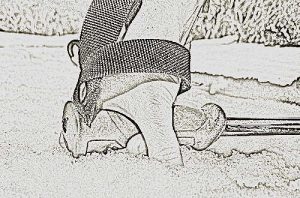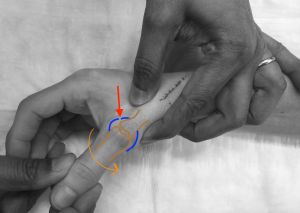Is There Anything I Should Know Regarding Skier’s Thumb?
• A ligament is the strong tissue that joins the bone of a joint together, provides stability and is commonly injured in skier’s thumb.
• This pathology was first identified in 1955 as a persistent ligament condition in Scottish poachers who regularly twisted the necks of hares, causing damage to their thumbs. At the time, the injury was known as “gamekeeper’s thumb.”
• Because of the rising popularity of downhill skiing and injuries to the thumb sustained following a fall, the phrase “gamekeeper’s thumb” has been supplanted with the more modern word “skier’s thumb.”
• A considerable proportion of skiing injuries include skier’s thumb.
• This damage must be surgically treated in extreme situations when the ligament has completely ripped.
• Because the ligament contributes to the thumb’s gripping function, its ultimate stability is critical.
• With adequate therapy, individuals with skier’s thumbs may be able to go to work or even ski in a short time.
Skier’s Thumb Causes:
Accidents on the slopes are the most prevalent source of injury to the tendon that produces skier’s thumb. Injuries to this ligament account for 8% to 10percent of total of all skiing incidents. A fall on to an open palm with a skiing pole in the palm, for example, generates the force required to strain the thumb and strain or rupture the ligament. A simple landing on an extended hand with an open palm does not normally produce much impact. The thumb, on the other hand, can be hurt if it slides into compacted snow at a fast speed.

A car accident in which the driver’s thumb is draped alone so over steering wheel is a less prevalent source of this injury. Skier’s thumb can be caused by any injury that causes the thumb to bend unusually backwards or to the side.
Symptoms of a Skier’s Thumb
These clinical signs may appear minutes to an hour after the damage has occurred.
• Pain in the web area between the thumb and the index finger at the root of the thumb
• Thumb swelling at MCP joint
• there is an inability to grip or a weakening of grasp; between thumb and index finger,
• Skin discoloration above the thumb that is blue or black in hue.
• Thumb ache that becomes worse as you move it in any direction
Diagnosis of a Skier’s Thumb
It’s important to see an hand surgeon if you have injured your thumb in a similar fashion.
Your surgeon will initially assess if you had any additional limb-threatening injuries before performing a more thorough examination of the thumb.
The surgeon will inquire as to how the injury occurred and add further questions like:
• Have you ever been injured in a similar way before?
• Have you ever undergone any form of hand or wrist surgery?
• Are there any pain relievers that you’re allergic to?
• Have you ever sustained a previous wrist or hand fracture?
• Are you a right- or left-handed person?
• What do you do for a living?
After that, the surgeon will conduct a physical examination.
• Its ligaments of the thumb close to the index finger side that are tested for laxity (looseness) in the following way: This test will include keeping the root of the thumb in place while delivering a lateral (sideways) push to the tip of the thumb to observe how far it will move. The motion of the damaged thumb will be contrasted to the motion of the unaffected thumb. This may be difficult to accomplish just after the injury due to pain (in which case the injury may be treated and then re-examined in a few days) and may be assessed after a local anaesthetic injection.

Treatment of skiers thumb:
The initial management of this injury depends entirely on the severity of the injury and degree of ligament damage .
Partial ulnar collateral ligament injuries are normally immobilised for 4-6weeks, however full ligament rupture frequently necessitates surgery. They may also be associated with a fracture/ boney injury and is best assessed with an x-ray.
A important variation seen with a severe injury , where the ligament gets trapped above other soft tissue and these do not heal unless treated surgically. If suspected clinically this is best assessed with an ultrasound scan.
Early identification can be treated satisfactorily with surgical repair, delayed presentations ( beyond 6 weeks) may necessitate ligament reconstruction using tendon grafts which is a bigger procedure.
After surgery and or a period of immobility in a plaster, your hand therapist and hand surgeon will then organise a bespoke splint and rehabilitation program. It usually takes a period of 6-10 weeks for this to heal fully.
Prevention of Skier’s Thumb
• During all falls, skiers should be trained to intentionally drop the ski pole. When skiing without a ski pole in hand, falling on with an outstretched hand should reduce the risk of harm.
• Riders also should be encouraged to utilise poles with finger groove grips rather than those with wrist straps or closed grips.
• If you keep your thumbs and fingers outside the steering wheel during a car collision, you can avoid getting skier’s thumb. Since most drivers are conditioned to grasp the steering wheel like a ski pole, this new pattern will need deliberate effort.
When Should You Seek Medical Help?
If a person develops any of the signs of skier’s thumb after an accident, they should seek immediate medical care and follow the surgeons recommendations for further management.
If you have injured your thumb please organise a review with a hand surgeon and book your consultation.
